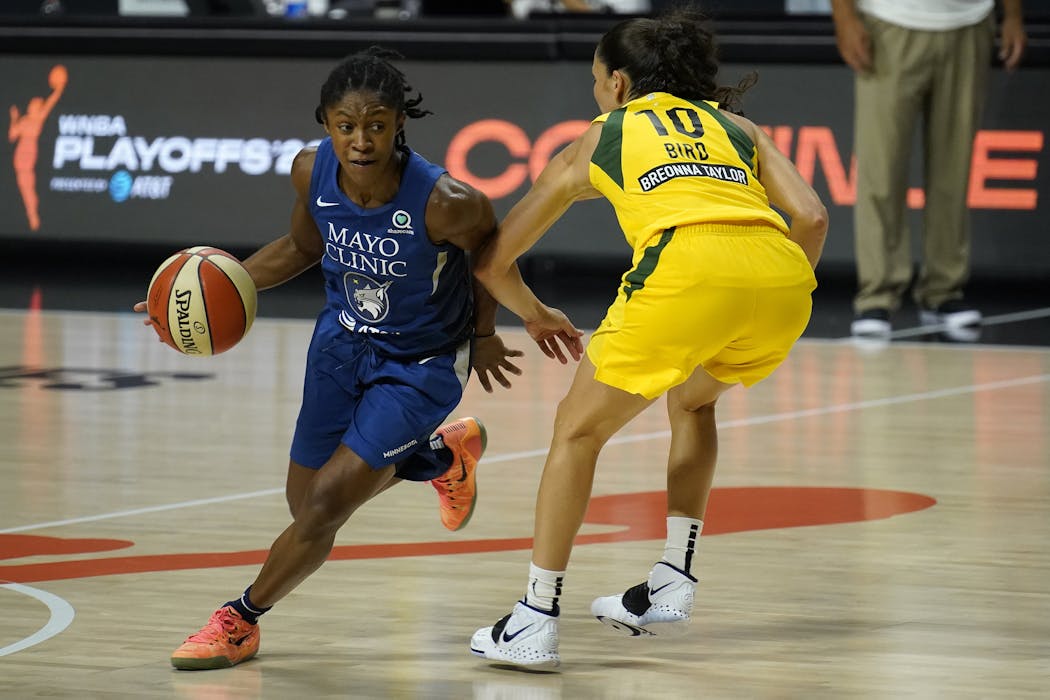People talk about Crystal Dangerfield's speed. And you can see it when she's running in transition or coming off a pick to attack the basket. But let's talk about the speed with which Dangerfield went from being the Lynx's second-round draft pick (No. 16 overall) to being the team's go-to player in the 2020 WNBA bubble. How she went from having discussions about having to be patient to being in discussions about being the league's rookie of the year.
Fast.
In the first week of this season's training camp, Lynx coach Cheryl Reeve was reminiscing about Dangerfield's emergence last year. How her flurry of steals and points transformed the season-opening game with Connecticut. How an early injury to center Sylvia Fowles put scoring responsibility on Dangerfield's seemingly slight shoulders.
How the rookie point guard picked up that load and ran with it.
But, as is often the case with Reeve, the other sneaker fell. "I know she got rookie of the year," Reeve said after a recent training camp practice. "But there was so much she didn't do. So there are plenty of places to go for improvement."
Reeve's laundry list: game-changing defense, teammate-enabling assists. Even more rebounding from a 5-5 point guard.
Said Dangerfield: OK.
It's not like Dangerfield refused to do any of that while becoming the first second-round pick in league history to win rookie of the year. It's just that, with almost no training camp and a condensed schedule that allowed for little practice, the 2020 season was a case of learn-on-the-go.
Fowles was out. The Lynx needed scoring. So Dangerfield scored. She led the team in scoring (16.2) and assists (3.6) and was second in threes per game (1.6). From the get-go, she became a player whose game took a jump in the fourth quarter, when she made about 60% of her shots. She scored in double figures in 19 of her 21 games, including the final 18, as the Lynx surprised many by finishing fourth in the league and advancing to the league semifinals.
But this year is different. Fowles is back. High-profile players Kayla McBride and Aerial Powers came via free agency. Reeve envisions a team with far more scoring options than a year ago. And Dangerfield, with her 2020 experience, now has a full camp to bear the full brunt of Reeve's expectations.
"We're going to have a lot of weapons," Reeve said. "She was charged with a lot of scoring [in 2020], and now we'll need greater balance."
OK.
"I think the biggest jump will come assist-wise," Dangerfield said. "And defensive-wise. Rebounding-wise, with Syl, it's going to be hard fighting for rebounds. But assist-wise, it's going to be a lot easier to find ways to make plays for other people."
This is not new to her. She never scored more than 14.9 points per game in a season at the University of Connecticut, playing with uber-talented teammates like Napheesa Collier, Katie Lou Samuelson, Kia Nurse and Azura Stevens.
"I am comfortable with whatever my team needs me to do," she said. "If it's score, I'll score. Pass? I'll pass."
Dangerfield spent much of the offseason in the Twin Cities getting ready, spending a lot of time in the gym with Fowles; Reeve envisions a lot of success for Dangerfield in a pick-and-roll game with the big center.
"There are lots of places for Crystal to go to that will be necessary for us in her second year," Reeve said. "We'll see if Crystal can repeat the great sophomore season that [Collier] had. It's hard to do."
Don't worry about her motivation. Dangerfield admitted last year that her draft position was motivation to prove people she should have gone higher. This year?
"Still thinking there is doubt I can do what I did last year," she said. "But it's self-motivation, not wanting to let myself down, not wanting that to be a one-year thing. That it's something I can build on and help my team win. Last year I wasn't happy with the way we left the bubble, and I took a lot of responsibility for that. I want to be a player my teammates can rely on."

Wild's victory over Montreal comes at a cost: Injuries to two key players

Minnetonka rolls past Anoka and into the Class 6A football Prep Bowl

How will Vikings' Bynum top his latest viral celebration?

Nebraska sinks Gophers in Big Ten volleyball match



